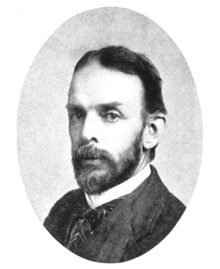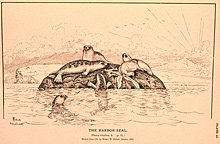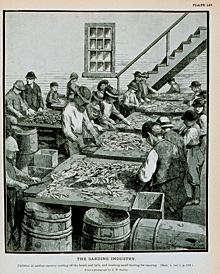George Brown Goode: Eminent 19th Century Fish Scientist
- Renowned Fish Scientist
- A Prolific Writer
- Making the Right Connections
- Collections & Writings from the Field
- A Variety of Special Assignments
- Final years
Renowned Fish Scientist

George Brown Goode, second United States Commissioner of Fish and Fisheries from 1887-1888. Click image for larger view.
The eminent ichthyologist (fish scientist), George Brown Goode (pronounced good´ee), worked for the United States Commission of Fish and Fisheries, the first predecessor organization of NOAA’s National Marine Fisheries Service, from 1872 until 1888. When he then became an assistant secretary of the Smithsonian Institution, Goode continued a working relationship with the Fish Commission until his death in 1896. His greatest contributions to fisheries science were as an administrator, curator, field biologist, and taxonomist; Goode also served as the U.S. Fish Commissioner from 1887-1888. From 1873 onwards he organized and administered the biological and fishery development research of the Fish Commission while placing in order and developing the taxonomic and ichthyologic work of the Commission and the Smithsonian Institution. He also organized and directed the Fish Commission and Smithsonian exhibits at international and national expositions between 1875 and 1884.
A Prolific Writer

Title page to Goode’s greatest work, Oceanic Ichthyology, published in 1895 while he was director of the National Muesum. Click image for larger view.
A fine writer, Goode authored more than 100 scientific notes and contributions in the reports of the Fish Commission and the Smithsonian Institution in addition to compiling catalogs and guides to exhibits. Goode, however, preferred writing books and monographs in which he could address and describe all facets of a subject, be it a fish, scientific problem, or the life of a colleague. His many books, often co-authored with Tarleton H. Bean, include The Fisheries and Fishing Industries of United States, a seven-volume work compiled from data gathered during the 1880 Census; American Fishes (1888); and Oceanic Ichthyology (1895).
Making the Right Connections
Goode was born in New Albany, Indiana, on February 13, 1851, and attended Wesleyan University in Middletown, Connecticut. His interest in natural history, and fish in particular, continued in graduate work at Harvard College where he worked in the marine science field schools led by Dr. Louis Agassiz. In 1871, Goode became curator of Wesleyan University’s Museum of Natural Science and there began developing a major collection of flora and fauna.
In 1872, Goode first went to work for the Fish Commission as a volunteer researcher in Maine, where he met Spencer Fullerton Baird, then Fish Commissioner and Assistant Secretary of the Smithsonian. Goode became Baird’s assistant and chief of the Division of Fisheries at the Smithsonian Institution in 1873 and, until 1877, divided his time between Fish Commission summer fieldwork, Wesleyan University, and the Smithsonian. Because of the close administrative link between the Fish Commission and the Smithsonian Institution, Goode effectively ran the fish research program of both organizations from 1873 to 1887.Collections and Writings from the Field

In the 1880s, Goode began a study on the status of American fisheries, including marine mammals, to serve as baselines for future investigations. Two atlases resulted that contained 532 sketches from various artists, including the one above of harbor seals by Henry Wood Elliott. Click image for larger view.
His fieldwork yielded significant collections of unknown species of fish and other marine life, and Goode systematically cataloged these collections, dividing specimens between the two museums. He published the Catalog of the Fishes of Bermuda in 1876, contributed scientific papers to the annual reports of the Fish Commission and the Smithsonian Institution, and prepared his monograph The Natural and Economical History of the American Menhaden, published in 1879. During a five-year period, Goode established the protocols for Fish Commission research and for the care and maintenance of the museum collections.
A Variety of Special Assignments
Goode was appointed assistant curator at the Smithsonian Institution in 1877 and devoted his time to the work of the Fish Commission and the development of the fishery division. In addition, the U.S. State Department used his expertise in statistics and fish biology during negotiations with Canada over fishing rights (1877), and, in 1879-1880, he was in charge of the fishery section of the United States Census. He represented the United States Fish Commission at the international expositions in Berlin (1880) and London (1883). He organized national natural history exhibits for the expositions in Philadelphia (1876), and New Orleans, Cincinnati, and Louisville (1884).
Final Years

Goode successfully gathered information on the state of American fisheries that he published in two atlases. Many of the sketchs he included in these volumes were beautiful works of art that captured an interesting segment of 19th century Americana. Click image for larger view.
Although Goode succeeded Baird as U.S. Fish Commissioner in 1887, he relinquished this position and chose to remain with the Smithsonian Institution as assistant secretary when the Fish Commission became an autonomous agency in 1888. Goode continued his connections with fisheries and fishery research, however. He based his penultimate book, Oceanic Ichthyology, on material gathered during the cruises of Fish Commission vessels, Albatross and Fish Hawk, and the Coast and Geodetic Survey vessel, Blake, in the northwestern Atlantic.
Goode died on September 6, 1896, just after completing a study of the first 50 years of the Smithsonian Institution. The Smithsonian published this book as a memorial to him in 1897. His life and work in ichthyology and taxonomy represented one of the most productive periods in both disciplines, and Goode set the methods and standards still used in fishery research today.









